The bulkhead in a plane is essentially a dividing wall — usually one that exists between crew areas like galleys, that separates passenger classes like first and economy, or in larger aircraft, walls in the middle of the plane behind mid-cabin bathrooms.
The first row of seats behind these walls are known as bulkhead seats. Depending on the plane, the first row of seats on the plane is likely a bulkhead row. If there’s first or business class, the first row of economy seats after that, which is likely separated by at least a partial wall, is also a bulkhead row.
On larger aircraft where there may be multiple classes of service but also a bathroom or two mid-plane, the first row beyond them is usually bulkhead seating.
Depending on your travel style and how you like to spend your time in the air, sitting in the bulkhead of a plane may be a wonderful or terrible experience.
Pros of bulkhead seats
There are plenty of reasons to opt for a seat in the bulkhead.
Extra room in front
Because there are no rows directly in front of you, most bulkhead seats offer a bit more space between you and the wall, which can help these rows seem more open and less claustrophobic. Those with long legs will often find their knees are farther from the barrier in front of them than they are in a typical economy seat.
Easy access
Bulkhead rows tend to offer faster, easier access to the aisle and bathrooms than other seats. Plus you’ll be in much closer proximity.
This is especially nice if you’re in the middle and the thought of having to climb over a fellow passenger to go to the bathroom gives you anxiety. Because there’s more space between the seats and the wall than between normal rows, you can much more easily slip out for a bathroom break or take a stroll up and down the aisles on longer flights.
No seatbacks in your space
Because there are no seats in front of bulkhead rows, sitting in one means no one will ever recline their seat into your space or spill the drink on your tray table by hastily tilting their seat forward or back.
Great for traveling with infants
If you’re traveling (usually internationally) with a lap infant under 2 for whom you didn’t book their own seat, the bulkhead rows are typically where you can hang a bassinet if the airline offers them. If you’re planning on doing so, make sure to get ahold of the airline ahead of time to reserve one.
Sometimes comes with early boarding
On some airlines, you may get access to early boarding or dedicated overhead bin space if you select a bulkhead seat. On Delta Air Lines, for example, some bulkhead seats may be located in Delta Comfort+, which comes with both. On American Airlines, they’re frequently Main Cabin Extra, which comes with the same perks.
Cons of bulkhead seats
Bulkhead seating isn’t a good deal for everyone.
More also means less (legroom)
While bulkhead seats do tend to offer more overall space, you’ll actually be a bit more limited if you really want to stretch out your legs. While regular seats have space underneath so you can slide your feet out farther, people with long legs may find their toes hit the wall before their legs are fully extended.
Close to hubs of activity
While it can be nice to be located so close to a bathroom or galley if you have to use the former frequently or like to be the first to be served snacks or drinks, this also means that more people will likely be gathering near your seat. There may be lines for the restroom or flight attendants constantly coming, going or chatting.
Everything is in the armrest
Unlike with most seats that have entertainment screens and a tray table built into the seatback in front of you, both may instead be located in your armrest, though this depends on the airline. This can reduce optimal movie-viewing angles and leave you feeling a bit more trapped in your seat when the table is fully extended. Some planes may still have screens on the wall, but that can make them harder to reach and control.
This also means that the armrests aren’t movable, which may make them feel more restrictive for larger passengers.
Less room to stow baggage
Because there’s no under-seat storage in front of you, you’ll have to store any carry-ons and personal items in the overhead bins. That’s only during takeoff and landing, and there are usually pockets so you can keep snacks, books and headphones at hand, but if you’re the type who’s always getting into your bag throughout a flight, you may find this annoying.
You may have to sit with infants
While parents traveling with infants may find the presence of bassinet hooks a blessing, those who would prefer not to sit next to a potentially crying baby may find the feature less appealing. Consider traveling with earplugs, just in case.
Often more expensive
On some airlines, you may have to pay extra for bulkhead rows. On Delta flights, these preferred seats come at a cost. On American, these seats are Main Cabin Extra, which start at $20 more. On other airlines, like Turkish Airlines, they’re considered economy seats.

